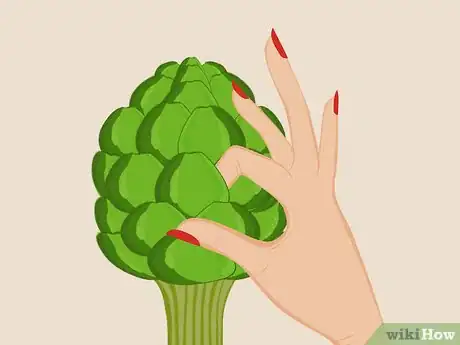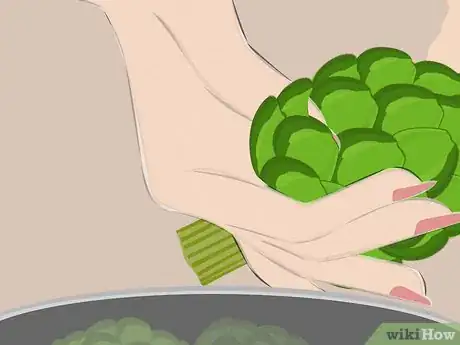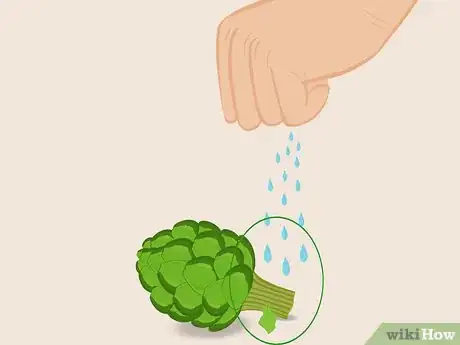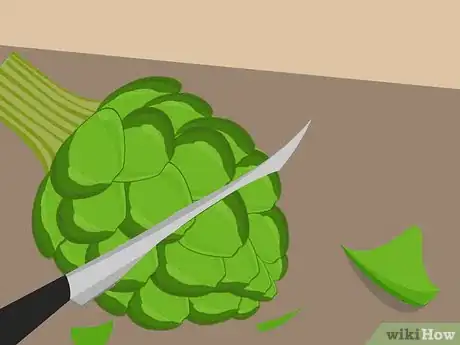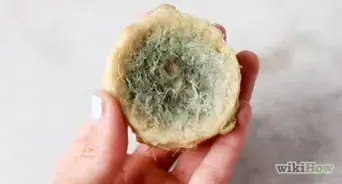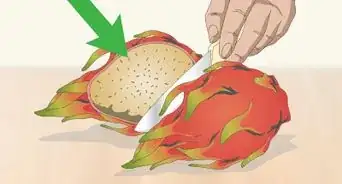This article was co-authored by wikiHow Staff. Our trained team of editors and researchers validate articles for accuracy and comprehensiveness. wikiHow's Content Management Team carefully monitors the work from our editorial staff to ensure that each article is backed by trusted research and meets our high quality standards.
wikiHow marks an article as reader-approved once it receives enough positive feedback. In this case, 97% of readers who voted found the article helpful, earning it our reader-approved status.
This article has been viewed 110,806 times.
Learn more...
Artichokes are a flavorful vegetable with an almost nutty taste, but their appearance can sometimes make them a little intimidating to shop for. It's true that knowing what to look for in an artichoke can mean a more delicious vegetable when you eat it, but finding a fresh artichoke isn't difficult. Once you know how it should look, feel, and even sound, you can pick out the best of the bunch. When you get the artichoke home, though, it's also important to know the proper way to store it or you'll have wasted time and money picking out the vegetables.
Steps
Choosing Artichokes
-
1Test the artichoke’s weight. A healthy, fresh artichoke should feel firm and heavy for its size. Lift the artichoke from the pile, and test its weight. You may need to compare it to other artichokes to ensure that it has a good weight for the size.
- Baby artichokes can be just as delicious as big artichokes. They obviously won’t be as heavy, though, so be sure to consider the weight of a baby variety with other baby artichokes.[1]
-
2Examine the artichoke’s leaves. If the artichoke feels heavy for its size, check out its leaves next. A healthy, fresh artichoke will have green leaves that are tightly packed. Some of the leaves may have purple undertones too, but be sure to avoid any that are brown at the tips.
- Don’t purchase an artichoke with leaves that are loose, splayed, dry, split, spongy, or pitted.
Advertisement -
3Squeeze the artichoke leaves. When an artichoke feels heavy and has healthy looking leaves, use the “squeak” test to confirm that you’ve picked a good one. Hold the artichoke next to your ear, and squeeze its leaves with your fingers. If you hear a squeak, the artichoke is extremely fresh so it’s a good one to buy.[2]
- A healthy artichoke’s leaves squeak because they’re still extremely crisp.
Storing Artichokes
-
1Leave the artichokes unwashed. While it may seem like a good idea to wash your artichokes before storing them, it can actually cause them to spoil faster. That’s because the peel can break down if there’s too much moisture, which can lead to infection.[3]
- You do need to wash artichokes before eating them. Just do it right before you plan to cook or prepare them.
-
2Sprinkle the stems with water. While you don’t want to wash artichokes before you store them, it’s important to ensure that the stems are somewhat moist when you refrigerate them. Sprinkle a few drops of water over the stems to keep them from becoming dehydrated.[4]
- Be careful not to use too much water when you’re sprinkling the stems or you run the risk of the artichokes growing mold. To avoid oversaturating the stems, you may want to use a spray bottle with a mist setting and spray the artichokes, holding the bottle at least 10-inches (25.4 cm) away.
-
3Place the artichokes in a plastic bag and refrigerate them. Once you’ve sprinkled the artichoke stems with water, set the artichokes inside a perforated plastic bag. Put the bag in the refrigerator -- if possible, place them in the coldest part of your fridge, such as the crisper drawer, so they’ll stay fresher longer.[5]
- The artichokes should keep in the refrigerator for up to a week.
Preparing Artichokes for Use
-
1Rinse the artichokes in cold water. When you’re ready to cook or prepare your artichokes, place them in a colander and rinse them with cold water. Use a soft cloth or brush to carefully rub away any film or residue that may be on the exterior of the artichokes.
- Be careful when you’re scrubbing the artichokes. If you’re too rough, you may damage some of the leaves.
-
2Trim the artichoke stem and leaves. After you’ve cleaned the artichoke, use a sharp knife to remove approximately ¼-inch (6 mm) from the stem. Next, use a pair of kitchen shears to carefully cut off the tips or thorns from the leaves.
- While you should always trim the stem, removing the tips of the leaves is an optional step because the thorns soften when you cook the artichokes.
- If you plan to stuff or fill the artichokes, you should remove the entire stem because it’s easier for them to stand up without it.
-
3Slice off the top couple of inches of the artichoke. Once you’ve trimmed the stem and the tips of the leaves, use a sharp knife to chop off an inch (25.4 mm) from the top of the artichoke. A serrated knife usually works best for cutting through the pointed top.[6]
- Keep the cut portion(s) of the artichoke from turning brown by rubbing them with a cut lemon.
-
4
Community Q&A
-
QuestionDoes cooking them longer make them more tender?
 Community AnswerYes, it does.
Community AnswerYes, it does.
Things You'll Need
- A stainless steel, serrated knife
- Stainless steel kitchen shears
- A perforated plastic bag
References
- ↑ http://www.latimes.com/style/la-fo-artichokes-s-story.html
- ↑ http://www.latimes.com/style/la-fo-artichokes-s-story.html
- ↑ http://www.splendidtable.org/story/listen-dont-look-to-your-artichoke-the-squeak-says-it-all
- ↑ https://www.williams-sonoma.com/pages/in-season-artichokes.html
- ↑ https://www.williams-sonoma.com/pages/in-season-artichokes.html
- ↑ http://www.oceanmist.com/artichokes/prepare-artichoke/
- ↑ http://www.oceanmist.com/artichokes/prepare-cook-serve-artichokes/
About This Article
To select and store artichokes, start by looking for artichokes that feel firm and heavy, which is a sign that they'll taste good. Also, make sure the artichokes' leaves are green and tightly packed. If the leaves are brown or loose, look for other artichokes to buy. When you're ready to store the artichokes you've selected, sprinkle some water on the stems so they don't dry out. Then, put them in a sealable plastic bag and store them in the fridge for up to a week. If you want to learn how to prepare the artichoke after it's been stored, keep reading the article!

